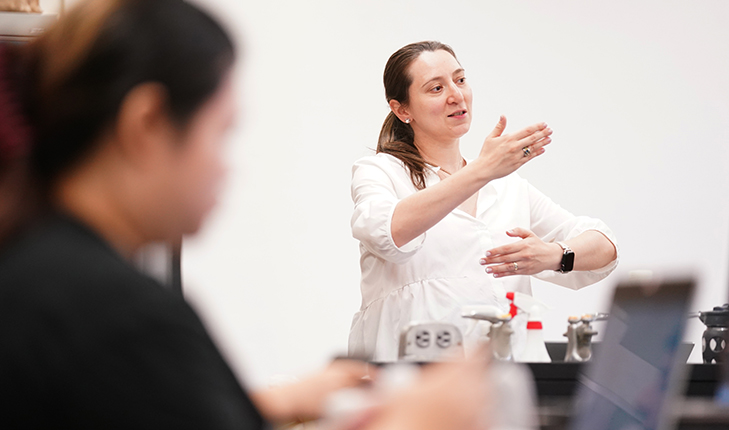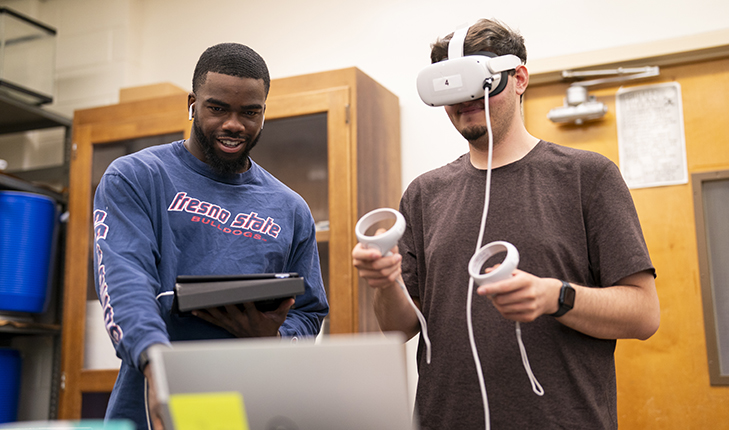Biology professor uses VR to help students visualize the human brain – Fresno National News
Skip to content
A biology professor uses VR to help students visualize the human brain
Fresno State senior Dustin Geringer donned a virtual reality (VR) headset for the first time this year to experience a three-dimensional and immersive learning experience about the nervous system and the human brain.
It’s confusing at first, and the glasses come off, but after a while, the technology becomes an extension of the hand, said the San Jose biologist.
“It’s an important learning tool for all ages,” said Geringer, after using the controllers to remove nerves, blood vessels and more from 3D scans of the human brain. in order to be able to record and study physiology laboratory images. this semester.
Starting in the spring of 2023, Fresno State biology professor Dr. Anahit Hovhannisyan has incorporated VR technology into some of her classes to help students visualize and memorize the structure of the human brain.
Hovhannisyan, a neuroscientist who has taught at Fresno State for six years, is technology and innovation. He was already looking for a program in his neuroanatomy class to allow students to study the anatomy of the human brain and explore real studies of the human brain when he saw a demonstration of syGlass VR at a meeting of the Society for Neuroscience. He said the program looked interesting and suitable for his class.
“Memorizing structures and learning their locations in anatomy classes is often about memorization, not so much about practicality. I was looking for ways to get my students to find a part that logical and easily learn anatomical structures, “Hovhannisyan said. “How can I improve memorization?”
It was part of a program at Lyles College of Engineering at Fresno State that trained faculty to implement VR in their courses. VR headsets and equipment, as well as powerful laptops capable of running graphics-intensive software, were provided through a program with the Fresno State Library with support from the Office of the Provost. Hovhannisyan also received funding from the dean’s office of the College of Science and Mathematics for the syGlass and VR program in his neuroanatomy laboratory class during the 2023 and 2024 academic years, and in his physiology laboratory this year. autumn.

Now, it was time to implement. There is a steep learning curve, Hovhannissyan said. Students must learn how to use VR and use a custom-made syGlass device with a variety of data tools. Once they got used to it all, they did a good job using the program, he said.
In a recent physiology lab, students broke into small groups of two to three and took turns reviewing the program and collecting data. A student at one point wore an Oculus headset and held controllers to begin their visualization of the human brain moving their arms and head up and down, from left to right. Others in the groups watched the interaction on a laptop screen.
Student feedback on the use of VR in the classroom was positive, Hovhannisyan said, although some complained about not having enough time and wished the class was longer. He takes that as a good sign.
“That’s really good. That means they were learning,” he said. “They didn’t just come to make pictures. They wanted to learn, and this showed that implementing this feature made them want to learn.”
Technology, especially robotics and artificial intelligence, is a 21st century process that is becoming a part of life, Hovhanissyan said. People were against the old calculator, but everyone uses it now, he said.
“We are using it as a tool and the same can be said about the development of technology and artificial intelligence tools,” Hovhannisyan said. “All these things need to be part of teaching so that students can use them as tools to improve their learning process and help them learn more easily.”
Share This Story, Choose Your Platform!
Link to upload page
#Biology #professor #students #visualize #human #brain #Fresno #National #News

